Tomo spent the week at the house doing paper work, and checking the kitchen progress while his two kids collected insects and frogs. He also managed to use these exquisite artist's washi (=Japanese paper), for our Shoji.
This one is blue, but we have the other side in green.
He passed the baton on to me, and I went again at my normal occupation - the preparation, application and finishing of mud-walls (again!).
The weather was on Saturday, so I first created adobe bricks to fill the special heat storing wall segment. Last time I made a start on it, but ran out of material. So on Saturday I made 24 bricks, which was three 20kg bags of sand and an nearly same amount in volume of red earth. My back muscles bear witness to the magnitude of the task.
Later it started raining and kept doing so the whole Sunday. But fortunately the DIY market had the Silica sand in stock, that is key ingredient of the finish wall layer. Despite the rain and the absence of volunteer helpers, I mixed up with pulverised straw, clay, a lot of silica sand and worked from 06:00h till 16:00h nearly without break.
I managed to finish 5 panels on the western side (darker coloured patches), covering the cracked and smoke blackened original wall, as well as one of our new wall panels (not shown on photo). The quantities of sand and clay should be chosen such that the clay merely makes the sand sticky. The trowel, then pushes the sand over the wall, evening out bumps. The straw prevents cracking. With a helper, the remaining panels should be finish-able within one day.
Sunday, 24 August 2008
Shoji and - again - mud walls
Taking shape
The two bedrooms are now ready for action - I confirmed the excellent comfort myself .. but I nearly slept over. But with so much work remaining for the weekend, it was just something I could not afford.
Here the left room:
And the one on the right:
The Kitchen is is also nearing completion, and is scheduled to be operational end of next week.
Posted by
Patrick:
1 comments
![]()
Labels: bed, bed room, comfort, huelsta, kitchen, sleep, sleep system
Tuesday, 12 August 2008
Waterfall Adventure
When popping into the tourist information office at the nearby michi-no-eki, Byron's eye was immediately caught by a poster showing the Fudodaki Waterfall.
It is only about 10 minutes drive from the house, and a 1km foot trek is required to reach this enchanted place.
View Larger Map
Without delay he moved his party to the place and everyone discovered there inner spiritual side. 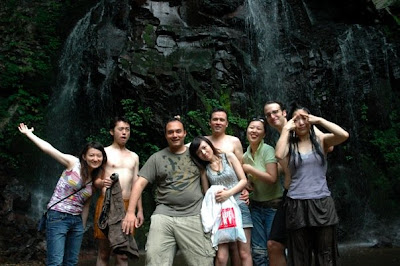
While first circling around the cold water ...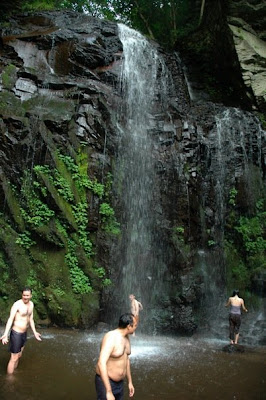
One after another dipped in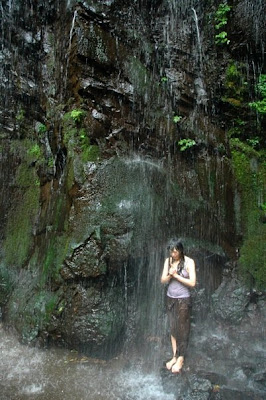
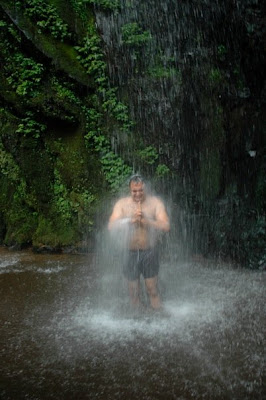
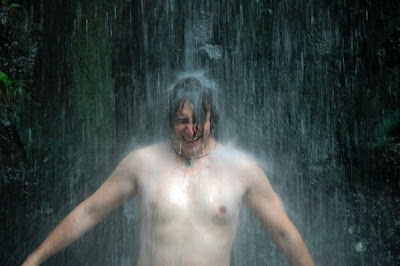
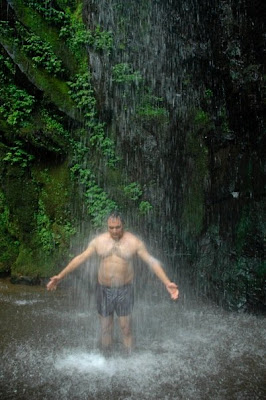
"The water was just the right temperature - not to cold. But because of the water pressure you could only endure about 20 seconds under the water" commented one of those Yamabushi afterwards.
Posted by
Patrick:
0
comments
![]()
Fantastic time at the house
Once arrived, they immediately relaxed and enjoyed the natural environment in the house and around it. The weather was fantastic - hot during the day, but not as humid as Tokyo, and cool at night - and a gentle breeze rang the wind chimes and provided natural cooling.
Because there is no fridge yet, a water cooler was improvised. Vegetables harvested the very same morning locally can be seen sharing the coolness with cans of premium malts.
In place of a kitchen the food was prepared in true Asian style (is this Bangkok?):
The summerly mood was further heightened when Byron started serenading Okinawa style:
And of course there was plenty of cheap Suika (Watermelon):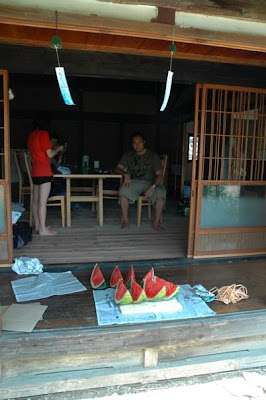
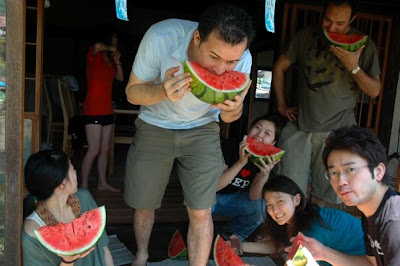
Posted by
Patrick:
1 comments
![]()
Labels: birthday party, friends, good time, melon, music, okinawa, suika, vegetables, water melon
Birthday Readiness
A party of 8-10 people was expected to come to inakahome this weekend, for bar-b-q and to celebrate Byron's (a friend) birthday. So we temporarily stopped all building activities and cleaned up the property, removing dangerous tools and piles of mud and cleaned the rooms.
The house still needs a little work, such as kitchen island and appliances, and lighting, but it is already usable for some things, such as having a relaxing day in the country side.
A view of the living room (need to add a finishing layer of mud plaster to some walls, and complete the brick section):
The lower part of of this side of the room looks nearly perfect already:
The flowers are grown local:
Posted by
Patrick:
0
comments
![]()
Labels: cleanup, living room
Sunday, 3 August 2008
Thunder and Lightning Art
The previous weekend we were dogged by bad luck with the weather. Whenever we wanted to start mixing mud, it started hammering down with rain. Hot and cold air fronts hitting each other created two full days of non-stop electric storms. As a result we didn't get much work done, however it was quite a spectacle to behold.
Our intention was to close the highest odd-shaped panels with mud, so we stapled some metal lath on the beams surrounding the openings. The reed was not really usable here because the openings were very small, and we couldn't fit the drill in. Unfortunately, the metal lath didn't work so well: it was floppy so that when applying a little pressure, bits and pieces of mud would fall off. If we used to much pressure, mud would just fall through the lath. I therefore tried to get some mud to stick at least, and next time we try it may offer a better, stickier surface.
In any case, while we battling the elements, a young, up-and-coming Japanese artist stayed at our house. Ryo Matsuoka absorbed the environment and atmosphere of the building, and surrounding fields+nature to create paintings on the Fusuma (Japanese sliding door), as well as a wood panel and a cupboard. You can find his impressions on his website: http://www.ryoart.com/nagawa08/08july.html
You can see the creation story here:
Of course we did not let the opportunity slip, and PeterO began a fully fledged improvised interview. Jan, his wife, kindly prepared and excellent translation that I used to add English subtitles. Interview is uploaded to youtube, and you can watch it here:
For those who don't have the patience to watch, here is the translation:
Interview with artist, Ryo Matsuoka, on July 27, 2008
Peter: First of all, thank you for coming to Inaka Home. I believe this is your second time painting on fusuma doors (Japanese sliding doors)?
Matsuoka: Yes
Peter: I understand that you have spent one night here already and that you will stay for another two or three days as you continue to paint. I have been watching you work today, and I am very interested to know what you saw and what you felt while staying here in order to come up with this image as your final product.
Matsuoka: Rather than creating a specific image, I clear my thoughts of everything and start from zero. That way, I can bring forth something new and fresh that incorporates all that I saw or felt or touched. I’ve been doing this since I was a child. I make a sketch diary of what I’ve experienced. These are some sketches I did while I stayed here. I picture things I experienced and then I clear everything out of my mind and relegate everything to zero and a bigger picture evolves.
Peter: You mention your sketch diary. For example, take the first one you have in your hand. What is that image? Is that a bird? Rather than objects, are these expressions of your feelings?
Matsuoka: Yes that’s right.
Peter: So then what was the feeling you felt when you created today’s images on the doors?
Matsuoka: What was it, I wonder? This is something that I can only create here and now. It’s hard to pinpoint an exact feeling or thought to this or to label a title to this piece. It started from the moment I got on the bullet train from Tokyo to come out here, eating, meeting people, hearing the thunder, being surprised by the beauty of the stars, seeing the biggest spider ever; all of these experiences from this place come together like a living book, which I throw against the panel and it creates this image.
Peter: You had mentioned that you sketch some images first, then you zero yourself and then you begin painting. As I watched you work today, I noticed that you would paint and then you would pause to look at what you painted and then you would paint again. In the first stage of painting, your pauses were about 10-20 seconds, and gradually the pauses became longer as the painting time became shorter. In the final stage, you would wait for 2-3 hours, then paint one stroke.
Matsuoka: (Laughing) Yes, that’s right. Interesting.
Peter: Can you tell us what is going through your mind during these stages?
Matsuoka: In the beginning, I work on a white canvas and follow my instincts. It’s not complicated nor strange, I just start painting and see where it takes me and see what shapes emerge, and follow along. Then I begin the process of slicing or shaving off layers and that’s probably when the time shift occurs.
Peter: Today’s date is July 27, 2008 and you can only draw this particular image today. So what will tomorrow’s image look like?
Matsuoka: I don’t know. Something very different.
Peter: You will also paint the areas to the right, in the tokonoma and on the other door?
Matsuoka: Yes, and also the door on the other side. I wonder what it will look like. I hope when I look at my finished product, I am surprised by it or am pleased with how it turned out. It’s something that was just instantly created and not preconceived.
Peter: Is this your technique as an artist?
Matsuoka: Yes, as a child I loved to draw and have been drawing ever since.
Peter: So you would call this abstract art?
Matsuoka: When I was little, my father would draw and sketch and use oils. And now I’m painting abstract art, but I also draw travel diaries. I draw words, or rather they are more like symbols. I try to embody words. If I meet someone, I would draw that experience. It is not so much my drawing of the impression I had, but more about the person himself. It’s like a diary. And this painting today is a part of my diary that I could only draw here. And this will continue on with the next place I visit and the next.
Peter: Thank you very much for coming to Inaka Home and for painting this for us.
Matsuoka: Thank you very much.
Posted by
Patrick:
0
comments
![]()
Labels: abstract, art, artist, Fusuma, Inaka home, inakahome, interview, Japanese, Japanese artist, lightning, painting, rain, ryo matsuoka, thunder

